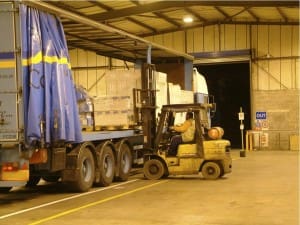In the US we speak about “pallet pooling services,” while in the UK people speak of “pallet networks.” It turns out these are two very different things. The UK and the US — two nations divided by a common language.
“Pallet pooling services” involve shippers renting pallets from companies like CHEP. These service providers collect the empty pallets at the end of the supply chain, inspect them, and efficiently move them back upstream to the shippers that need them.
In contrast, “pallet networks” are collaborative regional 3PL networks. Ali Karim, the Managing Director of The Hazchem Network, explained to me how they work. It used to be that national 3PLs with a network of nationwide depots dominated transport. To compete with the national 3PLs, regional 3PLs banded together to facilitate national shipments.
The way this works is a regional 3PL, let’s say in Wales, gets a shipment order destined for Scotland. The Welsh “haulier” moves the goods to a hub location in the center of the UK run by the network service provider. Ali tells me the “golden triangle” for network hub services is bounded by Birmingham in the North-Midlands, Rugby in the East-Midlands, and Leicester in the West-Midlands. The Hazchem Network’s facility is in Rugby.
At the cross-dock in Rugby, the Welsh company’s shipment is loaded on a truck that has come south from Scotland. Meanwhile, the Scottish carrier’s goods are loaded on another regional carrier’s truck, even to destinations offshore such as Ireland and mainland Europe.
This hub and spoke network is based on night moves – “Night Trunking.” A regional carrier’s truck might leave its warehouse starting at about 4:00 in the afternoon. The hub location accepts inbound shipments and unloads trucks until midnight. From midnight to 2:00 am outbound trucks are loaded. Once loaded, the driver heads back to his home region and arrives before dawn. The truck is likely carrying multiple delivery orders so the freight is distributed among smaller trucks for localized delivery. Once the transloading is complete, the truck is then available for use during normal daylight working hours.
According to Mr. Karim, once these “pallet pooling networks” were formed, they grew quickly, 30 to 40 percent per year in the 1990’s. Meanwhile, national carriers lost market share.
The Hazchem Network, as its name suggests, moves hazardous materials (hazmat). These are non-bulk shipments – drums on a pallet or dry chemicals in traditional packaging.
All pallet networks need a good collaborative IT solution to support this business model. A typical network service needs a web-based solution that gathers and uses information on a pallet’s ultimate destination, the number of pallets, the barcodes associated with those pallets, the weight of the pallet, the scheduled arrival time at the hub, and it needs to support multiparty payments and credits. This is tough enough.
Hazchem’s IT solution needed to do much more. The hub warehouse needed to be divided into zones based on the chemical classes. As the incoming truck enters the hub, it enters different zones where the relevant items are removed. When it is time to load, the system lists the consignments that need to be loaded onto the vehicle and the truck will then enter the appropriate zones in an optimal manner. The driver is handed a loading sheet. This sheet is given to the forklift driver in each section who is responsible for locating and loading the relevant pallets. When the driver leaves the final section, the pallet barcodes are scanned to ensure they correspond to the manifest generated by the system and that the pallets are loaded in the correct configuration on the truck.

Hazchem also needs to print the correct compliance documentation. To do this, the system needs the chemical’s name and the chemical class. They also need compliance data such as the transport chemical category and ‘proper’ shipping name, the UN number, packing group, and the tunnel code. The tunnel code ensures that hazardous chemicals are able to be carried through a particular tunnel. This is a ruling that came into law throughout Europe in 2009. Tunnels are graded A – E, depending on a specific tunnel’s risk assessment and how hazardous the material being transported is.
Hazchem created a database of chemicals so that shipment forms could be populated with a minimum of keystrokes. There are about 180,000 different UN numbers associated with packaged chemicals. Further, the database helps with the safety documentation for drivers. The safety document tells the drivers what to do in the event of an emergency, such as a spill, with the chemicals they are carrying. The document links to Hazchem Network’s nationally recognized 24/7 emergency response service. To ensure the correct IT would be deployed, Deltion was Hazchem’s main software partner for this project.
This is all pretty slick, and I’m not the only one who thinks so. Hazchem was the winner of the 2005 Logichem European Supply Chain Project of the year.
I can’t recall hearing of this type of collaboration between regional carriers in the US. The US, of course, is much larger, which makes this model more difficult to implement. But the carrier business is highly competitive; any model that increases fuel efficiency, backhauls, and truck utilization seems worth exploring.
















